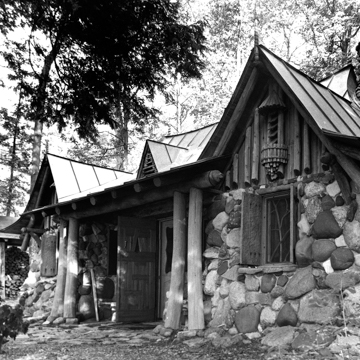Schoeber’s yearning to find refuge from urban life in the rustic outdoors was common among affluent Americans of the twentieth century, but he acted on it in an unusual way. On a terraced, wooded slope above rock-strewn Edgewater Beach, Schoeber, a local architect, built himself a fairy-tale cottage, a delightful bit of folk art. To make the dwelling blend with its environment, he gathered his own building materials from the site. Uncut boulders from along the shore form the walls, cedar log pillars hold up the front porch, and a large piece of driftwood serves as the overhead beam. He fashioned the original cottage doors (since replaced) from cedar poles, giving each door a tipi-shaped peephole. For windows, he used tree branches, taking advantage of their natural forks and knobs to form whimsical muntins. On the gable ends, he trimmed louvered windows with bundled-wood hoods and balconets. Elsewhere, cobblestone chimneys, beam ends shaped like acorns, and wooden shutters with animal carvings and strap hinges add to the storybook charm. Later, Schoeber added a log gazebo on the terrace below, cladding its conical roof in a scalloped pattern to resemble a lily pad.
You are here
Max Schoeber Cottage
If SAH Archipedia has been useful to you, please consider supporting it.
SAH Archipedia tells the story of the United States through its buildings, landscapes, and cities. This freely available resource empowers the public with authoritative knowledge that deepens their understanding and appreciation of the built environment. But the Society of Architectural Historians, which created SAH Archipedia with University of Virginia Press, needs your support to maintain the high-caliber research, writing, photography, cartography, editing, design, and programming that make SAH Archipedia a trusted online resource available to all who value the history of place, heritage tourism, and learning.











